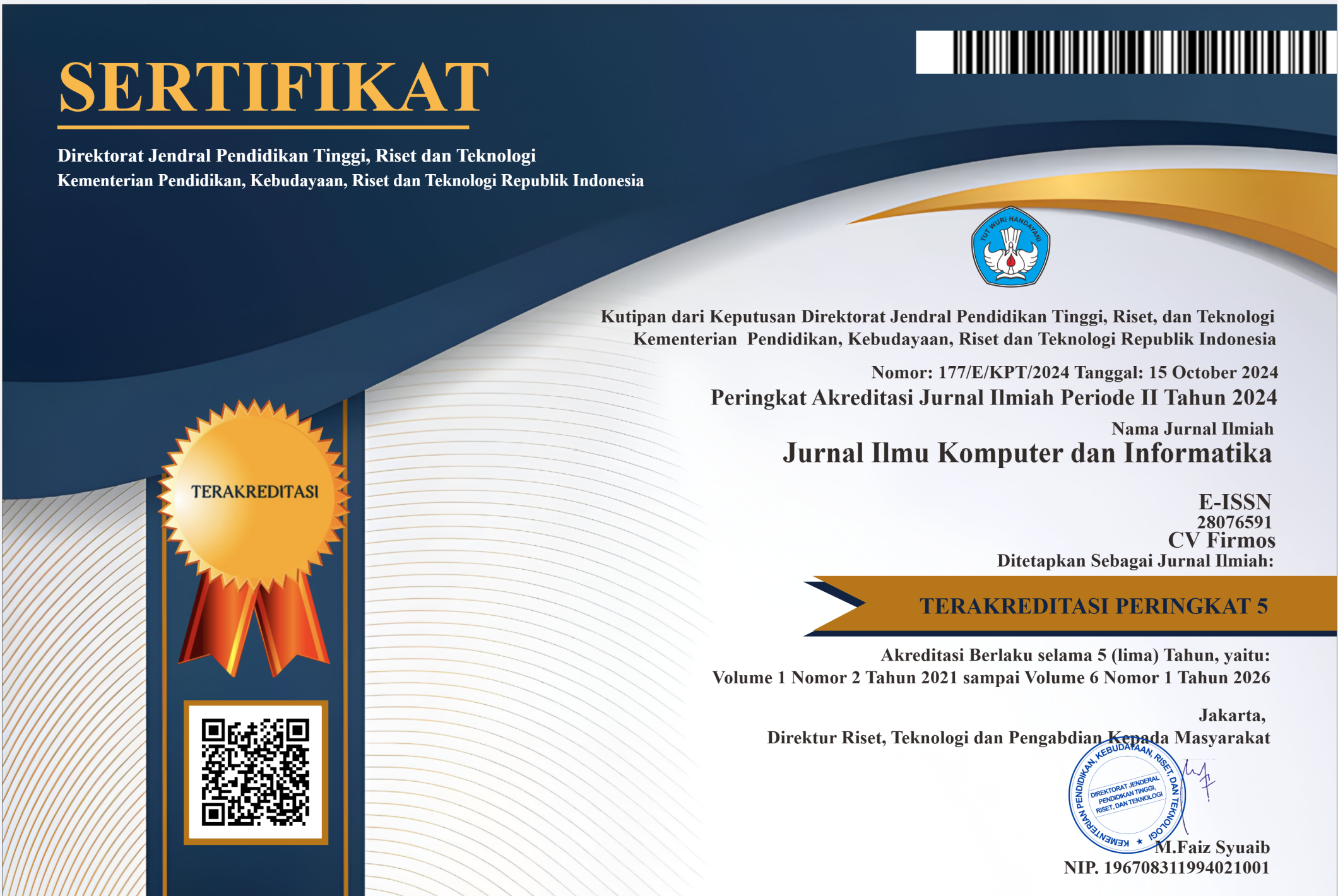Fire Detection Using Logistic Regression with GLCM, RGB Ratio, RGB Intersection, and Color Moments
DOI:
https://doi.org/10.54082/jiki.250Keywords:
Color Moments, Fire Detection, GLCM, Logistic Regression, RGB Ratio, RGB IntersectionAbstract
Fires pose a significant threat to human safety and property, particularly in densely populated urban environments where rapid and accurate early detection is critical. This study proposes an automated fire detection system based on computer vision and Logistic Regression classification, utilizing a combination of texture and color-based features to improve detection performance. The proposed approach integrates Gray-Level Co-occurrence Matrix (GLCM), RGB Ratio, RGB Intersection, and Color Moments to extract discriminative features from fire and non-fire images. The dataset, obtained from Kaggle, was preprocessed through HSV-based color segmentation to isolate candidate fire regions before manual annotation. The extracted features were then used to train a Logistic Regression model with hyperparameter tuning of the max_iter parameter to achieve optimal convergence. Experimental results show that the proposed model achieved an accuracy of 86% and a recall of 84% on the training dataset, and an accuracy of 87% with a recall of 82% on the test dataset. Despite these promising results, some false negatives were observed, indicating the need for further refinement to improve sensitivity. Comparative evaluation with a Convolutional Neural Network (CNN) demonstrated that the Logistic Regression approach achieved higher average processing speed, reaching up to 16.2 FPS for video input, compared to 11 FPS for CNN, making it more suitable for real-time applications. Overall, the integration of multi-feature extraction with Logistic Regression offers a balance between accuracy and computational efficiency for early fire detection in real-world scenarios.
References
I. Gede et al., “Deteksi api kebakaran berbasis computer vision dengan algoritma YOLO,” Journal of Applied Mechanical Engineering and Green Technology, vol. 3, pp. 53–58, 2022, [Online]. Available: https://ojs2.pnb.ac.id/index.php/JAMETECH
pemadam.jakarta.go.id, “Kaleidoskop Kejadian Kebakaran di Provinsi DKI Jakarta Selama Tahun 2023,” pemadam.jakarta.go.id.
J. Ryu and D. Kwak, “A Method of Detecting Candidate Regions and Flames Based on Deep Learning Using Color-Based Pre-Processing,” Fire, vol. 5, no. 6, Dec. 2022, doi: 10.3390/fire5060194.
F. Feiters Tampinongkol, C. Herdian, H. Basri, and L. Halim, “Identifikasi Penyakit Daun Tomat Menggunakan Gray Level Co-occurrence Matrix (GLCM) dan Support Vector Machine (SVM),” 2023. [Online]. Available: https://www.kaggle.com/
F. Feiters Tampinongkol, J. A. Ginting, C. Herdian, Y. Purnomo, H. Basri, and L. Halim, “Perbandingan Metode GLCM dan DWT Dalam Mengekstraksi Ciri Penyakit pada Daun Tomat,” 2023. [Online]. Available: https://www.kaggle.com/.
M. Ikhsan and A. Wiranda Hakiki, “Analisis Perbandingan Metode Histogram Equalization dan Gaussian Filter untuk Perbaikan Kualitas Citra,” 2024. [Online]. Available: http://jurnal.goretanpena.com/index.php/JSSR
practicalreporting.com, “How many bins should my histogram have?,” practicalreporting.com.
A. Barla, F. Odone, and A. Verri, “Histogram intersection kernel for image classification,” in IEEE International Conference on Image Processing, IEEE Computer Society, 2003, pp. 513–516. doi: 10.1109/icip.2003.1247294.
blog.datadive.net, “Histogram Intersection for Change Detection,” blog.datadive.net.
M. Abdan Mulia and Y. Arum Sari, “Klasifikasi Citra Jenis Makanan dengan Color Moments, Morphological Shape Descriptors, dan Gray Level Coocurrence Matrix menggunakan Neighbor Weight K-Nearest Neighbor,” 2019. [Online]. Available: http://j-ptiik.ub.ac.id
R. Herina Situngkir and P. Sembiring, “Analisis Regresi Logistik Untuk Menentukan Faktor-Faktor Yang Mempengaruhi Kesejahteraan Masyarakat Kabupaten/Kota Di Pulau Nias,” vol. 6, no. 1, pp. 25–31, 2023.
Palak Jain, “Activation Functions in Neural Networks - Part 2,” medium.com.
Downloads
Published
How to Cite
Issue
Section
License
Copyright (c) 2025 Pieter Dickens, Teady Matius Surya Mulyana

This work is licensed under a Creative Commons Attribution 4.0 International License.


















